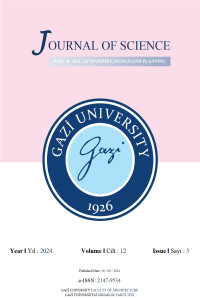Abstract
The Ottoman Empire, which continued to develop and utilize the state system inherited from the Anatolian Seljuks, also initiated significant reforms in architecture primarily during the reign of Sultan III. Ahmed. These reforms began primarily in the military sphere before permeating into society and manifesting themselves in the field of healthcare. With the establishment of the Ministry of Evkaf and Ebniye in the early 19th century, traditional hospitals (darüşşifas) were replaced by new-style hospitals. During the radical transformation in the state system in the early 19th century, referred to in Ottoman sources as the 'Reforms of Mahmud II', various changes occurred in the healthcare sector as well. Traditional hospitals designed like madrasas were replaced by Military and Civil hospitals where infectious disease wards were separated by high doors. Subsequently, the infectious disease wards evolved into separate buildings, and hospitals were designed as independent units. From the mid-19th century onwards, traditional hospitals gave way to modern hospital buildings. These newly designed healthcare facilities, referred to as 'hospitals' in contemporary sources and inscriptions, introduced a new architectural typology. The architectural style of these hospitals initially followed neoclassical and eclectic styles, later transitioning to national architectural styles. With the advent of the Republic, needs were identified in various fields including politics, economy, society, education, and healthcare. Policies were formulated to meet these needs and achieve a contemporary structure. Wars and epidemics during this period highlighted the inadequacy of healthcare facilities, leading to the necessity of constructing new buildings. Furthermore, modifications and additions to existing structures and changes in hospital layouts to meet evolving needs played a significant role in the emergence of modern hospital buildings, often in the form of independent units (pavilions). Teams including prominent architects such as Kemalettin Bey contributed to the development of hospitals during the Early Republican period, serving as pioneers for future constructions. Through an academic approach, examples of the transition from traditional healthcare institutions to modern ones within the borders of the Republic of Türkiye were presented, emphasizing architectural analyses based on plan diagrams to highlight the changes that took place.
References
- [1] Akdeniz, G., & Başağaoğlu, İ. (2003). Architectural Structure of Maltepe Military Hospital. IV. Turkish Medical History Congress, September 18-20, 1996, Ankara, pp. 203-212.
- [2] Altay, S. (2019). Ottoman Hospitals Converted to Sample Hospitals in the Atatürk Era (1924-1938). Atatürk Research Center Presidency. Ankara.
- [3] Atasoy, S. (2022). Late Ottoman Hospital Buildings in Türkiye(1827-1923), (Unpublished Doctoral Dissertation/Social Sciences Institute), Pamukkale University, Denizli.
- [4] Ayar, M. (2007). Cholera in the Ottoman Empire: The Istanbul Example (1892-1895). Kitapevi Publishing. Istanbul.
- [5] Bolak, O. (1950). Our Hospitals: Historical and Architectural Study of Hospitals Built from Ancient Times to the Present, Istanbul Typography. pp.41-42.
- [6] Çiftçi, A. (2004). Military Architecture in the Ottoman Empire in the 19th Century and Military Structures Built in Istanbul. (Unpublished Doctoral Dissertation), Yıldız Technical University Institute of Science, Istanbul.
- [7] İrez, F. (1990). II. Abdülhamid Döneminden Bir Çocuk Hastanesi: Hamidiye Etfal Hastanesi (Şişli Çocuk Hastanesi). [PDF document]. Retrieved from http://katalogtarama.cekulvakfi.org.tr/resimler/3/14/23132/m000002874.pdf
- [8] Kara Pilehvarian, N. (2000). “Bezmiâlem Valide Sultan's Gureba-i Müslimin Hospitals”. Eyüp Sultan Symposium III Proceedings, Istanbul, pp. 296-303.
- [9] Kara Pilehvarian, N. (2006). “The First Foundation Hospital: Istanbul Yenibahçe Gureba-i Müslimin Hospital”. Foundations Journal, 2006 Special Issue of the Foundation Civilization Year, Ankara, pp. 111-115.
- [10] Kara Pilehvarian, N. (2006). “The First Foundation Hospital: Istanbul Yenibahçe Gureba-i Müslimin Hospital”. Foundations Journal, 2006 Special Issue of the Foundation Civilization Year, Ankara, pp. 111-115.
Abstract
References
- [1] Akdeniz, G., & Başağaoğlu, İ. (2003). Architectural Structure of Maltepe Military Hospital. IV. Turkish Medical History Congress, September 18-20, 1996, Ankara, pp. 203-212.
- [2] Altay, S. (2019). Ottoman Hospitals Converted to Sample Hospitals in the Atatürk Era (1924-1938). Atatürk Research Center Presidency. Ankara.
- [3] Atasoy, S. (2022). Late Ottoman Hospital Buildings in Türkiye(1827-1923), (Unpublished Doctoral Dissertation/Social Sciences Institute), Pamukkale University, Denizli.
- [4] Ayar, M. (2007). Cholera in the Ottoman Empire: The Istanbul Example (1892-1895). Kitapevi Publishing. Istanbul.
- [5] Bolak, O. (1950). Our Hospitals: Historical and Architectural Study of Hospitals Built from Ancient Times to the Present, Istanbul Typography. pp.41-42.
- [6] Çiftçi, A. (2004). Military Architecture in the Ottoman Empire in the 19th Century and Military Structures Built in Istanbul. (Unpublished Doctoral Dissertation), Yıldız Technical University Institute of Science, Istanbul.
- [7] İrez, F. (1990). II. Abdülhamid Döneminden Bir Çocuk Hastanesi: Hamidiye Etfal Hastanesi (Şişli Çocuk Hastanesi). [PDF document]. Retrieved from http://katalogtarama.cekulvakfi.org.tr/resimler/3/14/23132/m000002874.pdf
- [8] Kara Pilehvarian, N. (2000). “Bezmiâlem Valide Sultan's Gureba-i Müslimin Hospitals”. Eyüp Sultan Symposium III Proceedings, Istanbul, pp. 296-303.
- [9] Kara Pilehvarian, N. (2006). “The First Foundation Hospital: Istanbul Yenibahçe Gureba-i Müslimin Hospital”. Foundations Journal, 2006 Special Issue of the Foundation Civilization Year, Ankara, pp. 111-115.
- [10] Kara Pilehvarian, N. (2006). “The First Foundation Hospital: Istanbul Yenibahçe Gureba-i Müslimin Hospital”. Foundations Journal, 2006 Special Issue of the Foundation Civilization Year, Ankara, pp. 111-115.
Details
| Primary Language | English |
|---|---|
| Subjects | Architectural History, Theory and Criticism |
| Journal Section | Architecture |
| Authors | |
| Publication Date | September 30, 2024 |
| Submission Date | March 31, 2024 |
| Acceptance Date | September 10, 2024 |
| Published in Issue | Year 2024 Volume: 12 Issue: 3 |


